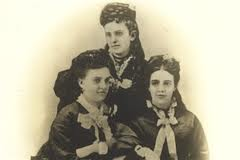“Carrie Chapman Catt, the person who was instrumental in getting women the right to vote, was in a sorority? You’ve got to be kidding me!,” exclaimed a student in the women’s studies discussion session I led years ago as a graduate student. Well, technically Catt was a member of a women’s fraternity, but the terms “sorority” and “women’s fraternity” are essentially the same, so yes, in fact, she was. And so this post will not be about Carrie Chapman Catt, the suffragist as there are many who write about her in that way, but as Carrie Chapman Catt, the fraternity woman.
Carrie Lane (Chapman Catt) was among the first females to graduate from Iowa State University. While there she became a member of Pi Beta Phi. Although she worked her way through school, she made time to be a member of the chapter. After graduating as valedictorian and the only woman in her class, she started teaching. While she was teaching school in Mason City, Iowa, she posed for pictures wearing her Pi Beta Phi arrow badge.
After graduation, Catt remained an active member of Pi Beta Phi and she utilized her fraternity connections. In 1887, she wrote the Iowa Beta Chapter of Pi Beta Phi at Simpson College offering to speak in Indianola, where Simpson College is located. She attended Pi Beta Phi’s 1890 convention in Galesburg and spoke about “The New Revolution.”

In May 1902, Elizabeth Gamble, Pi Beta Phi’s Grand President wrote to a friend:
While in Chicago station I met Mrs. Catt on her way from Montana – Had a long talk. She is going to try to get the N.Y. City – Pi Beta Phi together for a meeting Saturday morning before I sail, to organize. Have you met Mrs. Catt? I liked her.
When Gamble arrived in New York City a few days later, prior to boarding a ship for Europe, she received a letter at the St. Denis Hotel where she way staying. The Pi Beta Phi Alumnae in New York City had not yet organized an official alumnae club. Catt wrote to Gamble:
We talked with the Manager of the St. Denis over the telephone and secured their consent to hold our meeting in the reception room near the elevator, on the second floor, from 9:30 A.M. to 11:00 on Saturday morning. I then sent a letter to the seventeen names whose addresses were given on the list. There will not be time for them to send replies to me, and therefore, I did not ask them to do so. I do not know how many will come or whether any will come.
I would suggest that you speak to the management on Saturday morning, mentioning the fact a promise was given for this room, and that they should inform the elevator boy that the persons wishing to see Miss Gamble should be shown to this reception room. It would be well for you to be there a few moments before half past nine. I shall expect to be there promptly if possible, but as I live a long ways away, I may be delayed. We must arrange to dismiss you at eleven o’clock sharp so that you many have the full hour for you to reach your Steamer. Hoping to see you Saturday, I am, Yours Fraternally,”
She was the keynote speaker at Pi Beta Phi’s Eastern Conference in 1924. There, the portrait of First Lady Grace Goodhue Coolidge, a fellow Pi Phi, was presented to the nation.
She was the first fraternity woman to receive Chi Omega’s National Achievement Award, a gold medal presented to a woman of notable accomplishment.


In 1939, she was one of the speakers at the Panhellenic Day at the New York World’s Fair.

In Catt’s honor, Pi Beta Phi celebrates Chapter Loyalty Day on her birthday, January 9.
















